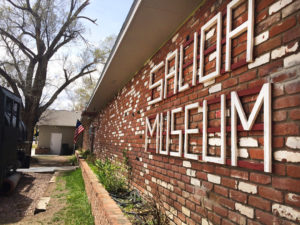By Peter Anderson
Forensics might have noted the fragment of a button from a dress shirt, the metal frame of the eyeglasses, the shred of fabric which may have been the handle of a book bag, suggesting a professor of some kind. The shred of a textbook cover – a title having something to with imaginative writing – would have indicated possible affiliation with an English department. Digital analysis of the car radio revealed that the driver had been tuned into a public radio station. Given the unending wave of Trumpian headlines at the time of burial, it may have been a suicide. Why else would someone drive a low-riding Mazda into a sand dune during a severe wind storm? Must have been a troubled liberal.
Here’s what really happened. I was coming home from Alamosa when I found out, in Hooper, that the highway headed north was closed. There had been an accident, maybe a fire. The wind that day had already blown half of the valley floor up to Nebraska. Visibility was only marginally better than a Dust Bowl day in Oklahoma. I turned west out of Hooper, figuring I could drive through Center, take 285 up to County Road T, and drive east from there into Crestone. That’s when the short cut occurred to me. Why go all the way west to 285? Why not head north on one of the many farm roads that ran up the center of the valley? Sand, that’s why.
But that didn’t occur to me as I turned onto a dirt road and drove off into the apocalypse.
It wasn’t an apocalypse at first, but an airborne farmhouse and a John Deere tractor caught up in a dustdevil led me to believe that I might be headed in that direction. I passed a sign that said “No County Road Maintenance Beyond This Point” – don’t worry, be happy – and kept driving north.
[InContentAdTwo] That’s when the world beyond my windshield began to drift in an easterly direction. What had once been a discernible set of tracks heading home was now someone’s back forty on the move. Only a nit-witted, knuckleheaded numbskull would continue driving. I put the pedal to the metal. And drove into a recently-formed dune. It occurred to me, given the isolation and the weather, that my own fossilization in a future bed of sandstone was a very real possibility. “He was headed west out of Hooper last they saw him.”
That’s when I heard the Lord speak: “Better dig your ass out pretty quick.” It was all I could do to open the door against the prevailing wind storm. Part of the dune flew in before I could close it behind me. My front tires were still visible, just barely. I swept armfuls of sand away until I could see the hubcaps – yes, progress! – and kept flailing away until I was able to rock that little Mazda around and back away from that man-eating dune, which followed me all the way back to the blessed asphalt of Highway 17 where I was able to escape.
There’s no place like home.
Peter Anderson lives in Crestone, Colorado, and teaches writing at Adams State University.


